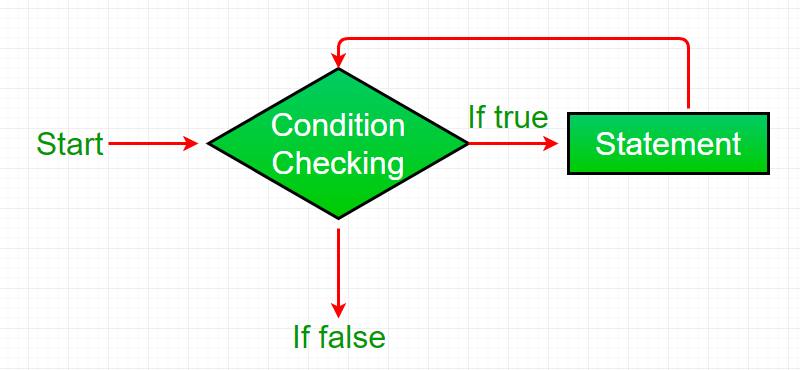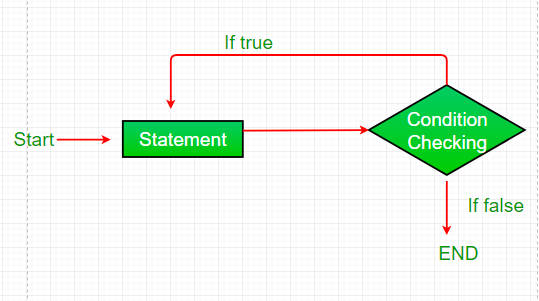编程语言中的循环是一种功能,它有助于在某些条件为真时重复执行一组指令/函数。 Java提供了三种执行循环的方法。虽然所有这些方法都提供类似的基本功能,但它们在语法和条件检查时间上有所不同。
- while循环: while循环是一种控制流语句,允许根据给定的布尔条件重复执行代码。while循环可以看作是一个重复的if语句。 语法:
while (boolean condition) { loop statements... }- While循环从条件检查开始。如果计算结果为true,则执行循环体语句,否则执行循环后的第一条语句。因此,它也被称为 入口控制回路
- 条件求值为true后,将执行循环体中的语句。通常,这些语句包含下一次迭代处理的变量的更新值。
- 当条件变为false时,循环终止,这标志着其生命周期的结束。
// Java program to illustrate while loopclasswhileLoopDemo{publicstaticvoidmain(String args[]){intx =1;// Exit when x becomes greater than 4while(x <=4){System.out.println("Value of x:"+ x);// Increment the value of x for// next iterationx++;}}}输出:
Value of x:1 Value of x:2 Value of x:3 Value of x:4
- for循环: for循环提供了一种编写循环结构的简洁方法。与while循环不同,for语句在一行中使用初始化、条件和增量/减量,从而提供了一个更短、易于调试的循环结构。 语法:
for (initialization condition; testing condition; increment/decrement) { statement(s) }流程图:

- 初始化条件: 这里,我们初始化正在使用的变量。它标志着for循环的开始。可以使用已声明的变量,也可以声明变量,仅限于循环的局部变量。
- 测试条件: 它用于测试循环的退出条件。它必须返回一个布尔值。它也是一个 入口控制回路 在执行循环语句之前检查条件。
- 语句执行: 条件求值为true后,将执行循环体中的语句。
- 增量/减量: 它用于为下一次迭代更新变量。
- 循环终止: 当条件变为false时,循环终止,标志着其生命周期的结束。
// Java program to illustrate for loop.classforLoopDemo{publicstaticvoidmain(String args[]){// for loop begins when x=2// and runs till x <=4for(intx =2; x <=4; x++)System.out.println("Value of x:"+ x);}}输出:
Value of x:2 Value of x:3 Value of x:4
增强的For循环
Java还包括Java 5中引入的for循环的另一个版本。增强的for循环提供了一种更简单的方法来遍历集合或数组的元素。它是不灵活的,只有在需要以顺序方式迭代元素时才应该使用,而不知道当前处理的元素的索引。 还请注意,当使用增强for循环时,对象/变量是不可变的,即它确保数组中的值不能修改,因此可以说它是只读循环,不能更新值,与其他可以修改值的循环相反。 我们建议尽可能使用这种形式的for语句,而不是一般形式。(根据JAVA文档) 语法:
for (T element:Collection obj/array) { statement(s) }让我们举一个例子来演示如何使用增强for循环来简化工作。假设有一个名称数组,我们想打印该数组中的所有名称。让我们看看这两个例子之间的区别 增强的for-loop简化了工作,如下所示-
// Java program to illustrate enhanced for looppublicclassenhancedforloop{publicstaticvoidmain(String args[]){String array[] = {"Ron","Harry","Hermoine"};//enhanced for loopfor(String x:array){System.out.println(x);}/* for loop for same functionfor (int i = 0; i < array.length; i++){System.out.println(array[i]);}*/}}输出:
Ron Harry Hermoine
- 趁此机会: do while循环与while循环类似,唯一的区别是它在执行语句后检查条件,因此是 出口控制回路。 语法:
do { statements.. } while (condition);- do while循环从语句的执行开始。第一次没有检查任何情况。
- 在执行语句并更新变量值后,将检查条件的真值或假值。如果计算结果为true,则循环的下一次迭代开始。
- 当条件变为false时,循环终止,这标志着其生命周期的结束。
- 需要注意的是,do while循环在检查任何条件之前至少会执行一次语句,因此是退出控制循环的一个例子。
// Java program to illustrate do-while loopclassdowhileloopDemo{publicstaticvoidmain(String args[]){intx =21;do{// The line will be printed even// if the condition is falseSystem.out.println("Value of x:"+ x);x++;}while(x <20);}}输出:
Value of x: 21
循环的陷阱
- 无限循环: 在实现任何类型的循环时,最常见的错误之一是,它可能永远不会退出,也就是说,循环会无限期地运行。当条件因某种原因失效时,就会发生这种情况。 例如:
//Java program to illustrate various pitfalls.publicclassLooppitfallsDemo{publicstaticvoidmain(String[] args){// infinite loop because condition is not apt// condition should have been i>0.for(inti =5; i !=0; i -=2){System.out.println(i);}intx =5;// infinite loop because update statement// is not provided.while(x ==5){System.out.println("In the loop");}}} - 另一个陷阱是,您可能通过循环向集合对象中添加了一些内容,可能会耗尽内存。如果您尝试执行下面的程序,一段时间后,将抛出内存不足异常。
//Java program for out of memory exception.importjava.util.ArrayList;publicclassInteger1{publicstaticvoidmain(String[] args){ArrayList<Integer> ar =newArrayList<>();for(inti =0; i < Integer.MAX_VALUE; i++){ar.add(i);}}}输出:
Exception in thread "main" java.lang.OutOfMemoryError: Java heap space at java.util.Arrays.copyOf(Unknown Source) at java.util.Arrays.copyOf(Unknown Source) at java.util.ArrayList.grow(Unknown Source) at java.util.ArrayList.ensureCapacityInternal(Unknown Source) at java.util.ArrayList.add(Unknown Source) at article.Integer1.main(Integer1.java:9)
本文由 Rishabh Mahrsee .如果你喜欢GeekSforgek,并想贡献自己的力量,你也可以使用 写极客。组织 或者把你的文章寄去评论-team@geeksforgeeks.org.看到你的文章出现在Geeksforgeks主页上,并帮助其他极客。
如果您发现任何不正确的地方,或者您想分享有关上述主题的更多信息,请写下评论。




![关于”PostgreSQL错误:关系[表]不存在“问题的原因和解决方案-yiteyi-C++库](https://www.yiteyi.com/wp-content/themes/zibll/img/thumbnail.svg)






